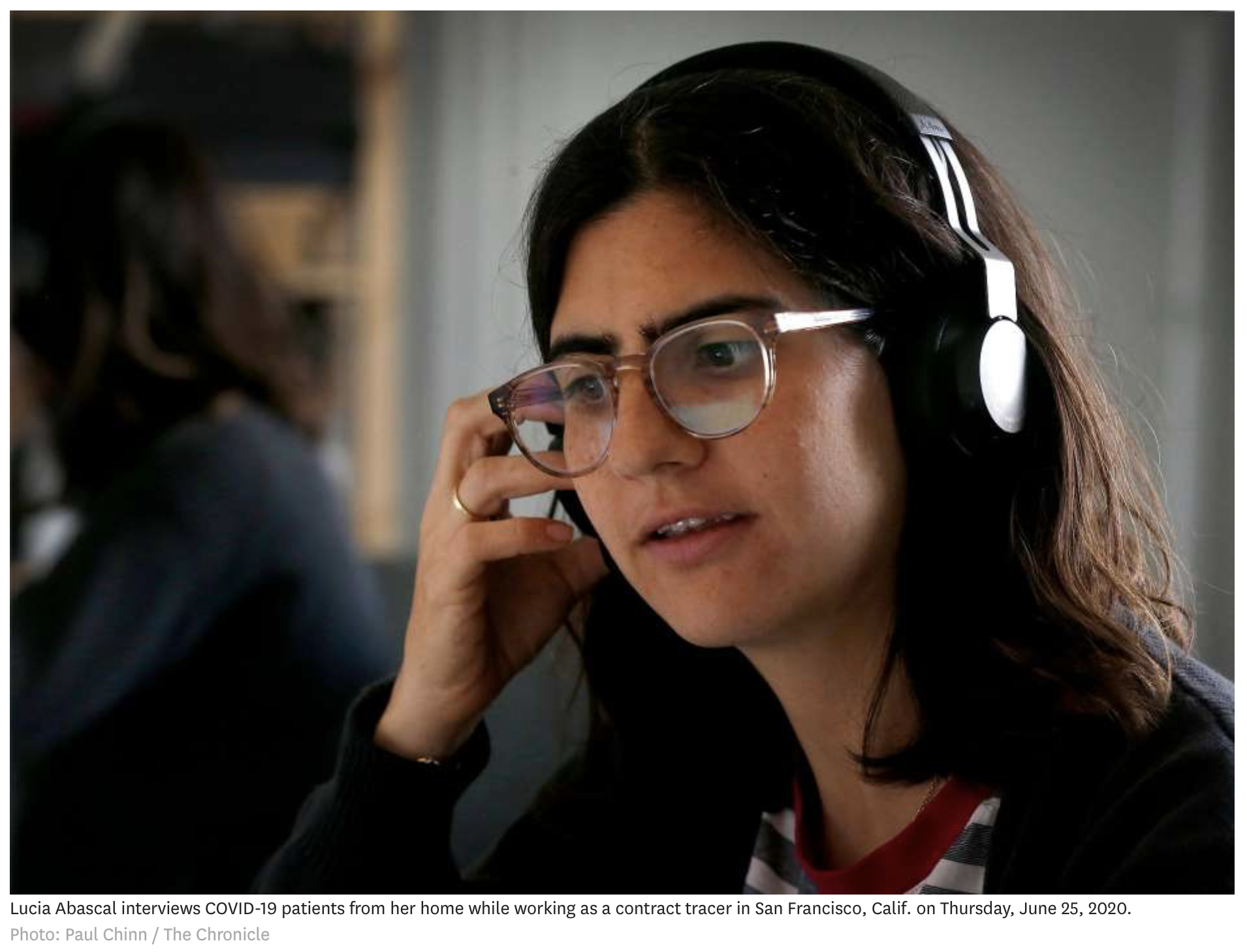Contact Tracing Article in SF Chronicle
This picture is from an earlier (more optimistic) SF Chronicle article on contact tracing.
My Contribution?
I would like to think that the following article in the San Francisco Chronicle came about in part because of a letter I wrote a couple of days ago. In reality I have no idea, but the article does address many points I made / asked in that letter which went out to both people in government and local journalists. I am working on digging into some stats from the San Francisco’s website and I hope to have a deeper discussion about where SF is currently at in the near future.
https://www.sfchronicle.com/health/article/Bay-Area-s-contact-tracers-struggle-amid-15419341.php
A Concerning Quote
Even counties that have maintained fairly high contact tracing numbers say they struggle with the surge.
“We want to be able to have a sustained conversation with all of the contacts, but when the numbers spike up, it diminishes our ability to do that,” said Kimi Watkins-Tartt, director of the Alameda County Public Health Department. “The conversations are little more clipped.”
Since cases in the county have more than doubled to about 150 to 200 a day, up from 60 to 80 in early June, the interaction often just covers the basics, she said: You’ve been in contact with someone who tested positive, please contact your provider, here’s how to quarantine.
Follow-up calls to see whether contacts have tested positive or developed symptoms have also had to go by the wayside for now.
Interesting Statistics
I am not sure how deeply one can infer from the statistics quoted but its an additional bit of anecdotal information.
The case investigations — interviews with newly diagnosed people — shed light on how the virus has spread since shelter-in-place orders were eased.
“We are seeing more people who were at some kind of gathering; that’s a common source of exposure,” Jenssen said. Contra Costa County investigators found that 18% of those who tested positive had attended large gatherings in the previous 15 days, while 17% had been to in-person workplaces. About 20% had visited restaurants, supermarkets and other stores.
Interconnection between Testing and contact tracing.
I had raised the insidious effect of testing delays in my rant about testing and you can see that playing out in the quotes below.
She pointed to delayed test results as a major obstacle. While the median turnaround time in the county is four days, many results come in as late as 10 days after testing — by which time a person may not longer be infectious.
And it’s not just results that take a while: In parts of the Bay Area, some people must wait a week or more for a testing slot to open up.
… If test results are delayed, he said, “you just move on. There’s a short shelf life for contact tracing.”
My Original Letter
Hi All,
I am deeply concerned that despite what I consider to be San Francisco’s well educated response to COVID-19 that we’re losing the most recent skirmish. I want my community to better understand the point at which we find ourselves currently. I think that one of the best ways of doing this is for the city government to disseminate more information about contact tracing.
Why is the virus growing here?
The reproductive rate of the virus is well over 1. This is despite the fact that I see most people in the city wearing masks. Cases are growing despite the fact that we currently have no sanctioned activity in the city that brings people indoors without masks on. Cases are growing even though San Francisco’s data website indicates that we’re very close to meeting our contact tracing goals.
Release contact tracing reports either as statistics or as anonymous case studies preferably both.
How are cases spreading? I want even anecdotal evidence about how cases are spreading. The citizens and the media need information about how cases are spreading. The city has this information in the form of it contact tracing reports. These reports should be made public either either through their statistics or by taking some of the individual reports that SFDPH feels are representative, anonymizing, and releasing them. Ideally the city should do both. These sorts of anonymized reports are being generated by other countries and I don’t see a problem with releasing similar information here in SF. If there is an issue please let me know what it is and figure out a way around it.
What are the issues being seen on the ground.
The release of contact tracing reports at least give the citizens a feel for what the hell is going on.
Are cases being imported from outside San Francisco?
Are people gathering informally without masks on?
Are younger people being less cautious?
Was there a large outbreak in a particular business or sector?
How much unidentified community spread is going on?
Not just numbers- Stories too.
Numbers can only go so far in getting citizens to act. I am a data scientist and I understand the significance of an Re of 1.2 and that number scares me. If you want people to back off their exuberant reopening and be more conservative, if you want people to go along with the closures that might be coming down the road, then tell the stories about how COVID-19 is actually spreading.
As impressed as I am with San Francisco’s response to the pandemic I am deeply disappointed to see this resurgence. My kids aren’t going to be able to go to school this fall because either my government screwed up or its citizens screwed up (probably a bit of both). Let’s figure out how to actually squash this virus. Get stories of COVID-19 spread out for everyone to see.
If there are ways you think I can help, let please let me know.
Thank you for your service everyone,
Peter Khoury
Phoenix Data Project
